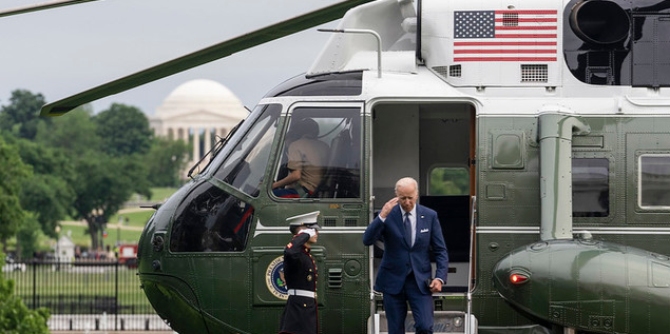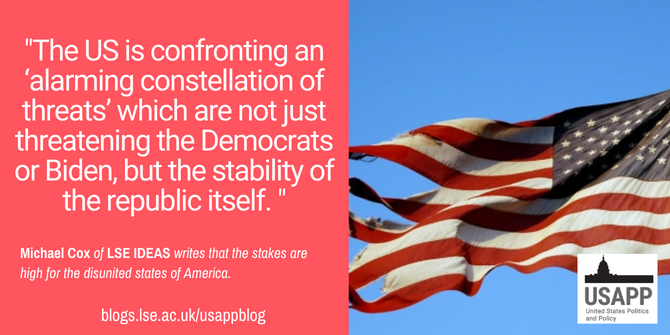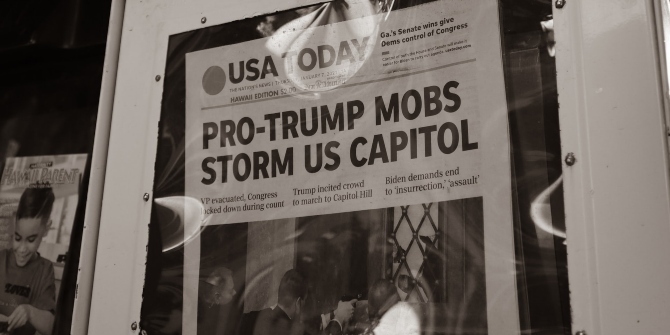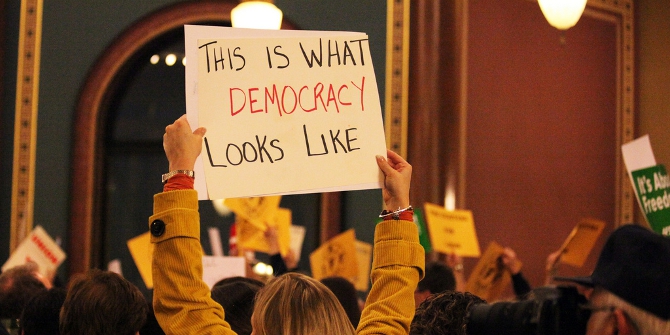 The increasing polarisation of American society has raised questions over the future of the American state and nation. As the 2022 midterm elections near, Michael Cox gives an overview of the growing divisiveness in America during Joe Biden’s presidency. The war in Ukraine, economic and inflationary woes, and an ever-increasing divide between Democrats and Republicans will all play a role in the way America attempts to locate its identity domestically and on the global stage.
The increasing polarisation of American society has raised questions over the future of the American state and nation. As the 2022 midterm elections near, Michael Cox gives an overview of the growing divisiveness in America during Joe Biden’s presidency. The war in Ukraine, economic and inflationary woes, and an ever-increasing divide between Democrats and Republicans will all play a role in the way America attempts to locate its identity domestically and on the global stage.
Whatever happened to the American dream?
For a nation constructed around the guiding idea that the future is always bound to be brighter than the past, it is almost impossible today to discover any American of note who would demur from the view expressed in June 2020 by the New York Times that there is an ‘epic crisis’ confronting the country. In part caused by Trump’s mishandling of the COVID-19 crisis, in part by the rise of social media, but over the longer term by profound changes in the structure of the American economy, the nation, it was argued, was facing some immense challenges.
But as the author of the piece, columnist David Brooks, asserted, the problems confronting the country would not be easy to solve. As he argued in an even more downbeat piece published a few months later, the US was not just going through a crisis, but was experiencing something close to an ‘earthquake’, a ‘moral convulsion’ no less. This found expression in various ways but most critically in an almost complete collapse in trust. This was not how things were in the past he noted. In 1964 for example a full 77 percent of Americans said they trusted the federal government. Towards the end of the Trump presidency many years later, that figure had nose-dived.
“This is flying over the IOOF graveyard i…” (CC BY-SA 2.0) by Rich Anderson
Nor was the Times the only publication of note to be concerned about the contemporary challenges confronting that once celebrated and much admired ‘City on the Hill’. Think Tank report after Think Tank report seemed to talk about little else. Large scale studies on the dangerous rise of nativism, new and compelling work on growing inequality, and a vast number of popular books explaining why the US was in terminal decline, all pointed to a nation that could hardly be described as being at peace with itself. One Brookings report published in early 2021 certainly did not mince its words. America, it argued, was facing nothing less than a ‘crisis of despair’ amongst a once confident people, including the ‘white working class’ who in their despair had turned to Donald Trump to provide them with solace and protection in a world over which they felt they had little or no control.
Even the denizens of high art finally woke up to the fact that there was something not quite right in America. Indeed, one leading gallery was even moved to bring together ’40 leading American photographers and 120 works’ in an exhibition which they simply entitled: ‘America in Crisis’. The exhibition left one with little place to hide with graphic and powerful images on display of brutal police facing down ‘rioters’ in an America divided against itself along nearly every conceivable line: from race to gender through to how one understood American history. Not that there had ever been a consensus about America’s past. Never, however, had there been such a division about how to view America’s long tortuous rise from British colony to superpower. As one writer aptly put it, most Americans once used to agree that there was a ‘collective national story’ around which they could all congregate. Now there were just several opposed narratives.
Un-civil wars
Inevitably the exhibition also included that most filmed and photographed of all events in recent US history: the storming of Congress on January 6th 2021, the culmination of a long period in which the US, according to many writers, had moved from being a country in crisis to a country on the brink. Nor of course has this first act in what some feared was the beginning of a ‘second civil war’ been forgotten. Certainly the Congressional hearings which have gone on to investigate the origins of the attack itself has done a brilliant job in outlining the steps that led to the attack, reminding people (if they needed reminding) of one simple fact: that President Trump used every means at his disposal from threatening the Department of Justice to pressuring senior republican officials in Georgia and Arizona to overturn an election which he had been told on several occasions (by members of his own family no less) that he had lost. Then, having failed to get his way by ‘peaceful means’, he inspired an insurgent attack on Congress to prevent Biden officially becoming President.
Photo by little plant on Unsplash
Naturally enough, the deeper causes of America’s multiple fissures have been much debated with some analysts of a more Democratic persuasion (understandably) laying all the responsibility at Trump’s door, others to the economic fallout from the financial crisis of 2008 and the downside consequences of globalisation, and a few to the ending of a Cold War which for all its dangers did at least provide the country with a unifying enemy around which to unite. Some would even trace the rift back to the 1960s when America began to come apart and a new generation of radical liberals began to set their own agenda on a whole range of issues from abortion to gay marriage, in turn setting off a backlash amongst that large but significant ‘silent majority’ who proclaimed their loyalty to the flag, their devotion to the American way, and a belief in a God who couldn’t be anything other than deeply conservative.
Whatever the cause or causes of the current malaise, there is little doubt about its consequences. Thus, one set of Americans it seems get their news from one single source – CNN (if you’re liberal) – while another (Trump supporters) gets theirs from Fox News. This in turn has impacted on Congress with an increasingly right-wing Republican Party standing on one side of the aisle glowering at their enemy, the Democrats, on the other, and the Democratic Party doing the same. Nor is there any doubting the impact all this is having on American perceptions of their own country. Hence, most liberals now think it is almost impossible to work with republicans. Meanwhile, most republicans, and even more extreme Trump supporters like the Proud Boys and QAnon followers, do not think Biden should even be in the White House. Indeed, as a series of rather disturbing polls have shown, somewhere between 50 to 70 percent of all Republicans agree with Trump that the election was stolen, and that Biden is not a legitimate President.
The economy and the Mid-terms
Biden also faces one other uphill struggle as his party moves towards the mid-terms in November: namely a US economy in trouble. Few doubt the American economy’s resilience or capacity to innovate and compete globally. The almighty dollar, the number of Nobel prizes won in the US, and the fact that eight of the top ten world companies in the world are American, taken together tell their own story of an economic system with formidable strengths. Even now as the stock market falters – 2022 saw the biggest drop in years – jobs were still being created at an impressive rate.
But as Time magazine reasonably asked, if the economy was in such good shape why is everybody feeling so gloomy? The simple answer is inflation and the measures taken to deal with it. It is the making of a perfect storm with on the one hand ordinary Americans facing a major hike in the price of basic goods like food, gas and rental accommodation, and on the other a Federal Reserve determined to crush inflation by raising interest rates and causing what many otherwise sober pundits now suspect is almost inevitable: a recession or something close to it. Even one of the less pessimistic analysts who thought a recession ‘unlikely’ still conceded that if developments either took a turn for the worse at home (for instance an uptick in COVID-19) or abroad (most worryingly a possible recession in Europe caused by Russia stopping natural gas supplies) then a ‘US downturn could certainly happen’.

“P20220524ES-00010” by The White House is United States Government Work
Either way, there is little likelihood that the material situation for ordinary citizens will get better any time soon. Moreover, it does not matter to them whether professional economists agree, or disagree, that the economy would or would not grow by one or two percent in the near or medium term. They are hurting now. Nor are things likely to improve any time soon. As one analyst put it, consumer confidence is dropping like a stone. Nor is it just weak growth that loomed. According to another poll, a full-scale recession is waiting over the horizon.
Biden’s team could of course claim, and have, that under his leadership COVID-19 no longer wreaks ‘havoc’ on the country, that unemployment is ‘near historic lows’ and that new businesses are being created at ‘record rates’. Nonetheless, going into a mid-term election when there is still so much economic uncertainty poses a huge political challenge. Whether this leads to the ‘historic shellacking’ that some are predicting is by no means a given. But there can be little doubt that ‘high prices and economic uncertainty are weighing heavily on the minds of many voters’. For a President whose approval ratings continue to be as low as they are – 40 percent and falling in June – the political omens are not good.
Ukraine to the rescue?
It has often been argued that the most effective way of uniting a nation at home is for it to engage in a war abroad. Having an enemy at the metaphorical gate, as the British classicist Arnold Toynbee once observed, is the best means of rallying people and cementing their loyalty to the state. But it does not always work out like that.
Indeed, Biden began his presidency not with a declaration of war but the opposite. He may well have supported the interventions in Afghanistan in 2001 and Iraq in 2003, but he was politically astute enough to know that by the time he became President several years later, the American people were fast looking for a final withdrawal from both and a move to focus laser-like on sorting out the nation’s many domestic woes
As it turned out, pulling back from Iraq (where only a couple of thousand troops remained anyway) proved relatively painless. Getting out of Afghanistan, however, turned into a nightmare with damaging images broadcast around the world of Afghans desperately trying to flee the country fearing (reasonably) its take-over by a completely unreformed Taliban.
There is little doubt that the way in which the withdrawal from Afghanistan was managed severely damaged Biden’s already less than stellar reputation for competence. He may not have regretted his decision to leave. Nor it seems did the American people. Nevertheless, images of ‘crowded runways of people desperate to get out, with some hanging from the outsides of US cargo planes’ did nothing to improve his or America’s standing domestically or internationally. Biden may have claimed in his successful run for office that under his stewardship America would be ‘back’ leading the West. But perceptions across the Atlantic after Afghanistan were overwhelmingly negative.

Photo by Yohan Marion on Unsplash
Indeed, even the most avid of Atlanticists feared that the US was not only retreating from the world, but also appeared to have little or no interest in what its closest allies either thought or said. As one US news outlet generally more sympathetic to Biden was forced to concede, there was ‘no way’ of spinning ‘events’ in Afghanistan ‘as anything but a domestic political, and geopolitical, wreck’.
In one of more extraordinary twists of history, an invasion that nearly everybody – except the American intelligence community, Biden, and a few experts – claimed would never happen, appeared to provide the Biden administration with a way back. Russia’s ‘special military operation’ against Ukraine not only spelled the end of the post-Cold War era in Europe, it also provided Biden personally and the Biden team more generally with an opportunity to restore some semblance of credibility. Republicans may have claimed that if Trump had been in the White House, Putin would never have dared invade Ukraine. This however was not the feeling amongst his allies in Europe. Here the US looked as if it was leading from the front culminating in late June with a crucial summit in Madrid which, in effect, transformed NATO.
Meantime at home, Biden scored several successes in persuading Congress to pass six aid packages for Ukraine. This may not have persuaded his political enemies that he was doing a good job. Still, various surveys taken at the time told a slightly more positive story with around a half of all Americans polled in March supporting his actions over Ukraine. Even so, the split between Democrats and Republicans remained as high as ever with only 18 percent of Republicans supporting his policies. Americans overall may have been keen to back Ukraine, but the chasm between the two parties remained as wide as ever. Previous wars in which the United States had been involved tended to unite Americans around their ‘Commander-in-Chief’. Such was the level of polarization after Trump that this simply did not happen.
Nor finally was the war in Ukraine without its risks for Biden. His own party may have stood four square behind him, yet few Americans wanted to see the United States getting more deeply involved in Ukraine itself. Many, moreover, looked forward to some settlement of the conflict within the not-too-distant future. There was the additional problem for Biden that some Americans might either begin to make a link between their own difficult economic situation at home and the conflict going on in Ukraine – increased gas prices being the more obvious connection – or more likely, wonder what the country was doing getting involved in an overseas war when the real challenges facing the United States were at home. Backing Ukraine remained the morally right and strategically necessary thing to do according to Biden and most foreign policy experts. Whether an increasingly inward looking American public would continue to buy into that narrative if the costs continued to escalate, and the war looked as if it would go on for an indeterminate period of time, remains to be seen.
But what about the world?
But what about the world ‘out there’? How is it viewing what is happening? The simple answer in most cases is with very great trepidation. Putin may be wondering how best to exploit America’s problems, while China no doubt hopes the current crisis will make the US less able to play a leading role in Asia. But it is hardly a secret that America’s principal allies remain very worried about the future. Trump’s going may have brought temporary relief. Yet the very real concern remains in Europe that Trumpism remains alive and well and could easily make a comeback as it looks like it could do in the mid-term elections of 2022 and has a fair chance of doing in the race for the White House in 2024.
It is of course possible that the very extremism displayed by Trump and his allies and supporters will help the Democrats. Some Democrats are even hoping that recent decisions taken by the Supreme Court on abortion and gun control will drive more moderate Republicans into their welcoming arms. This however may be grasping at straws given the state of the economy, Biden’s very low personal ratings, and the contempt in which he is held by most Republicans.
Trump meanwhile continues to loom large in the shadows. The odds of him running and winning in 2024 may have been slashed because of recent revelations about his role in the attack on Congress in January 2021. Yet even if he does not run – and that is by no means a given – this will not change the direction in which the republican party has been traveling since he exploded onto the political scene in 2016. Nor will it help heal the deep divide that has pulled the United States apart over the past few years. As the foremost international historian of global crises Adam Tooze recently observed, the US is confronting an ‘alarming constellation of threats’ which are not just threatening the Democrats or Biden, but the stability of the republic itself. The stakes for the US, and indeed for the world at large, could hardly be higher.
Please read our comments policy before commenting.
Note: This article gives the views of the authors, and not the position of USAPP – American Politics and Policy, nor the London School of Economics.
Shortened URL for this post: https://bit.ly/3cU4Ei7
About the author
 Michael Cox – LSE IDEAS
Michael Cox – LSE IDEAS
Professor Michael Cox is an Associate Fellow on the US and Americas Programme at Chatham House, Emeritus Professor of International Relations at the London School of Economics (LSE), and one of the founding Directors of LSE IDEAS. He is author or editor of several books, including a collection of his own essays The Post-Cold War World (2018), a centennial edition of J.M. Keynes’s The Economic Consequences of the Peace (2019), and a new edition of E. H. Carr’s 1945 classic Nationalism & After (2021). His latest book published in 2022 is entitled Agonies of Empire: US Power from Clinton to Biden.








